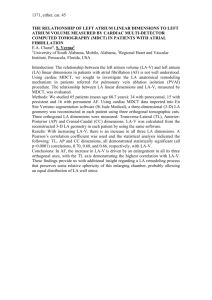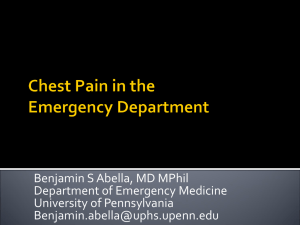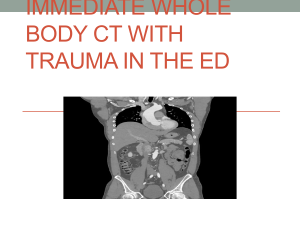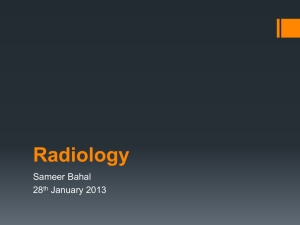Sixty-Four-Slice Computed Tomography of the
advertisement
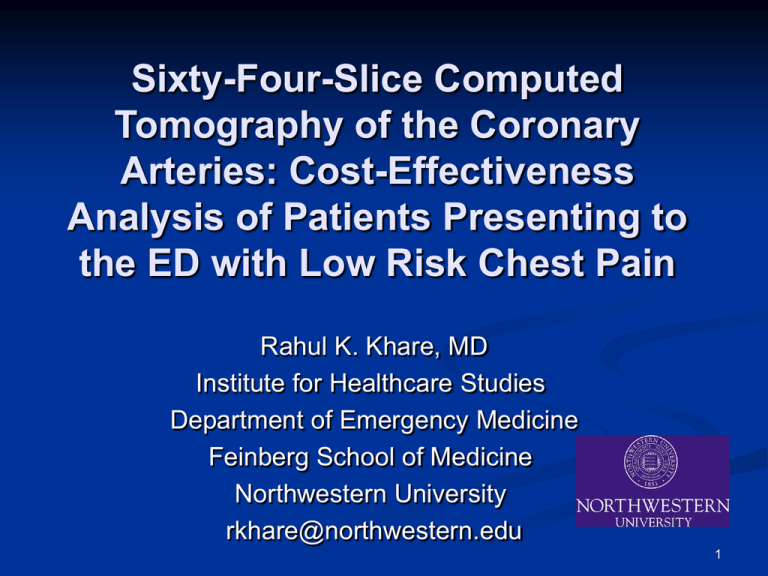
Sixty-Four-Slice Computed Tomography of the Coronary Arteries: Cost-Effectiveness Analysis of Patients Presenting to the ED with Low Risk Chest Pain Rahul K. Khare, MD Institute for Healthcare Studies Department of Emergency Medicine Feinberg School of Medicine Northwestern University rkhare@northwestern.edu 1 2 Chest Pain In the Emergency Department “Chest Pain” Most common Emergency Department diagnosis in patients 50 years or older Over 50% will not be diagnosed with coronary artery disease The identification of chest pain patients with significant coronary artery disease remains a challenge 3 Strategies One strategy is the use of chest pain observation units (OU) in the ED EDs have developed OUs to efficiently and safely manage low risk chest pain patients with serial cardiac enzymes and subsequent cardiac stress testing There is still a significant cost and time investment involved 4 Current Management of LowRisk Chest Pain in the ED 54 year old male complains of chest pain Patient smokes & has high blood pressure ED course Near normal ECG First cardiac enzymes are within normal He is now chest pain free 5 Current Strategy 7.7% of missed myocardial infarctions die You cannot send this patient home Admit to the observation unit Continuous telemetry monitoring Serial cardiac enzymes Either a stress echo or stress ECG 6 New Potential Management 64-slice multidetector computed tomography of the coronary arteries (MDCT) - new modality for evaluation of CAD Some advocate use of MDCT in the ED for low risk chest pain patients as an alternative to Observation Unit and stress testing. Not current standard of care in the ED setting 7 Rationale MDCT may become a first-line screening instrument for detecting significant CAD in low risk patients presenting to the ED with chest pain It is unclear whether the increased cost of the MDCT test is associated with better patient outcomes 8 Objective To estimate the cost-effectiveness of MDCT in the ED compared to the current standard of care for the evaluation of low risk chest pain patients presenting to the ED 9 Study Design Decision analytic model Compare the health outcomes and costs that result from different risk-stratification strategies for ED patients with low risk chest pain 10 Population 54 year old male, low risk chest pain Reflects the average age and most prevalent gender 3 Scenarios 1) OU care followed by stress ECG testing 2) OU care followed by stress echocardiography 3) No OU care, MDCT done in ED 11 12 OU + Stress Echo Tree 13 MDCT Tree 14 Inputted Parameter Sensitivity/Specificity Sensitivity MDCT, % Specificity MDCT, % Sensitivity Stress Echocardiography, % Specificity Stress Echocardiography, % Sensitivity Stress ECG, % Specificity Stress ECG, % Probabilities Probability of CAD, % Probability of Missed CAD-Death, % Probability of Missed CAD- MI, % Probability of Missed CAD- Health, % Probability of Death after Angio, CAD Pos, % Probability of Death after Angio, CAD Neg, % Probability CABG, % Probability of Med Management, % Probability of PCI, % Probability of CABG and Death, % Probability of CABG and MI, % Probability of Med Management and Death, % Probability of Med Management and MI, % Probability of Death after PCI, % Probability of MI after PCI, % Base Case Analysis Range Used in Sensitivity Analysis 99 84 85 70 74 69 80-100 60-100 60-90 60-90 60-90 65-90 6 7.7 44 49 0.1 0.02 10 10 80 3.0 3.3 2 2 2.5 8.5 1-70 2-75 10-75 10-75 .05-.5 .018-.02 1-50 1-50 50-99 1-10 1-10 1-5 1-5 1-10 1-50 15 Inputted Parameter Cost MDCT, $ Stress Echocardiography, $ Stress ECG, $ Angiography, $ PCI, $ CABG, $ OU Physician and Hospital, $ Missed CAD and Death Missed CAD and MI Utility Alive-Health Alive-MI Death Life Expectancy Life Expectancy after Health, yrs Life Expectancy after MI, yrs Base Case Analysis Range Used in Sensitivity Analysis 1500 277 105 2278 12228 35723 1712 58745 15549 $750-$3000 $188-$750 $78-$312 $1282-$5126 $8273-$33092 $23240-$92958 $856-$3424 $29373-$117490 $7776-$31098 1 0.88 0 0.5-0.95 24.77 11.2 16 Healthcare Costs All costs were adjusted to 2007 U.S. dollars using the Medical Care component of the Consumer Price Index. No discounting was necessary as costs and cost-effectiveness were examined for a 30day period after adjustment to 2007 dollars. 17 Sensitivity Analysis Test robustness of the results to changes in model assumptions and estimates Threshold sensitivity analysis To determine at which point these input parameters resulted in a substantial impact on cost, effectiveness, or cost-effectiveness of each modality 18 Probabilistic Sensitivity Analysis Conducted a Monte Carlo analysis to evaluate uncertainty by varying all of the input model variables simultaneously to assess the overall variability of the model Each scenario was simulated 10,000 times using Monte Carlo simulation This method accounts for variability among individuals and tests, which more closely resembles reality. The 95% confidence intervals of the ICERs were determined 19 Results Stress ECG Stress Echo MDCT Cost $3,461 $3,265 $2,684 QALYs 24.59 24.63 24.69 ICERs Echo vs. ECG (95%CI) Dominant (Dominant$123,467/QALY) ICERs ICERs MDCT vs. ECG MDCT vs. Echo (95%CI) (95%CI) Dominant (Dominant- Dominant (Dominant$7,332/QALY) $29,738/QALY) Dominant: Less Costly, More Effective 20 Sensitivity Analysis MDCT remained dominant to the other strategies because it had better outcomes and lower costs Five input parameters that resulted in the MDCT having higher costs than OU + Stress Echo cost of MDCT > $2,097 Base case ($1500) cost of OU care < $1,092 Base case ($1712) prevalence of CAD > 70% Base case (6%) specificity MDCT < 65% Base case (84%) indeterminate rate MDCT > 30% (3.8%) 21 Limitations Our analysis relies heavily on published assessments We use sensitivity and specificity of the MDCT from of studies with a CAD prevalence of 64%. All input parameters taken from the literature may be overor understated in this low risk OU population Radiation from a 64-slice scanner evaluating the coronary arteries has a lifetime risk of cancer Patients who have significant CAD on MDCT do need to get another catheterization. This requires another dye load, renal pathology is not modeled 22 Conclusions MDCT strategy is less costly and more effective than both OU based strategies in chest pain patients presenting to the ED Largely due to the diagnostic test performance of MDCT and the avoidance of OU costs 23
